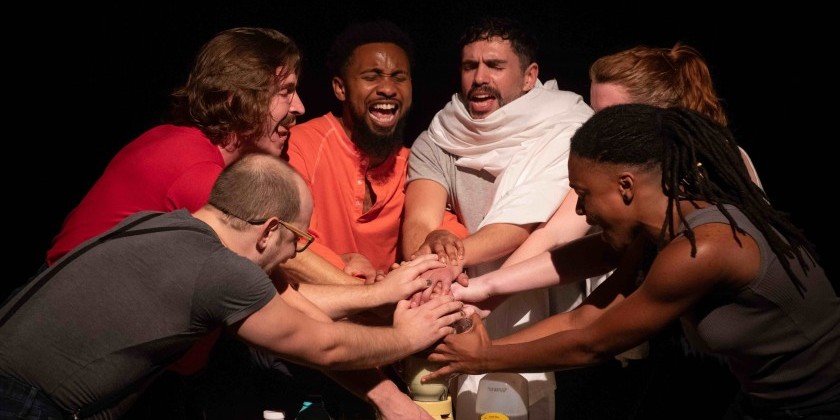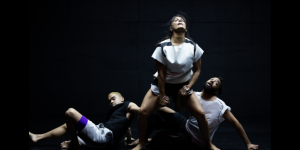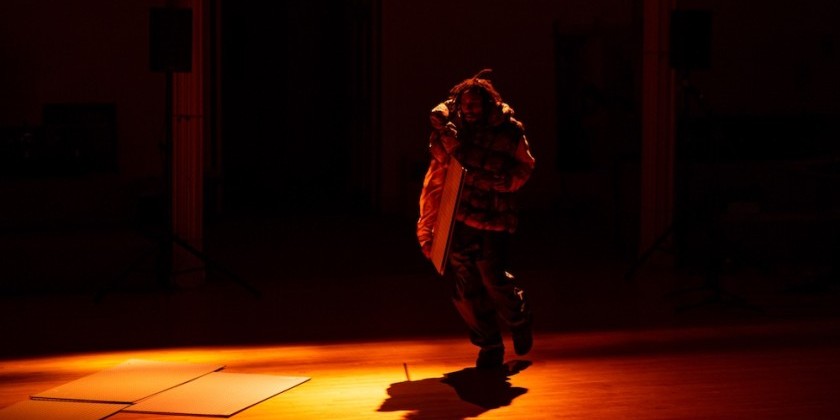IMPRESSIONS: "Variations on Themes from Lost and Found: Scenes from a Life and other works by John Bernd (reprisal)" at Danspace Project

Conception: Ishmael Houston-Jones | Creators: Ishmael Houston-Jones and Miguel Gutierrez based on choreography, text, and drawings by John Bernd
Music: Nick Hallett based on compositions by John Bernd
Consultation: Jennifer Monson
Lighting: Carol Mullins | Drawings: John Bernd | Video Design: Alvaro Gonzalez
Recording engineer: Jeff Cook | Mastering engineer: Sarah Register | Rehearsal Assistant: Amit Noy
Performers: Raha Behnam, Toni Carlson, Estado Flotante, Charles Gowin, Ishmael Houston-Jones, Kris Lee, Johnnie Cruise Mercer, and Alex Rodabaugh.
Variations on Themes from Lost and Found: Scenes from a Life and other works by John Bernd (reprisal) is many things. It is a work that explores, reconstructs, and enlivens a rich archive of movement, text, music, and drawings by multidisciplinary artist John Bernd. It is a many-layered performance of commendable compositional integrity, artistic virtuosity, and dramatic cadence. It is densely alive and moving in its complete immersion in the present moment as a vehicle for simultaneous processes of remembering, storytelling, and imagining. Yet at its heart, it feels most like an act of love.

Originally conceived for Danspace Project’s Platform 2016, Variations grew from the seed of a found item: a zine compiled in 1998 to commemorate the tenth anniversary of Bernd’s death from AIDS complications at age 35. Friends and caretakers of the artist, including Ishmael Houston-Jones, wrote letters, essays, and stories and collected drawings, postcards, and photos in a remarkable instance of community-based archiving as a means of coping with loss. The zine is included in a limited edition reprint of the Platform 2016 catalogue, Lost & Found: Dance, New York, HIV/AIDS, Then and Now.

Cover of Lost & Found: Dance, New York, HIV/AIDS, Then and Now
Houston-Jones’ rediscovery of this highly personal archive led to a comprehensive exploration of Bernd’s body of work, the co-creation of Variations with choreographer Miguel Gutierrez and composer Nick Hallett, and the digitization of Bernd’s complete archive for public access at the New York Public Library for the Performing Arts Jerome Robbins Dance Division. Curator and researcher Kristin Juárez describes the archival process as a means of “building a fact” through overlapping acts of research, recovery, and conservation that aim to construct a representative collage of the artist’s life and work. Stewarded with an ethos of care, the public archive expands its capacity to look forward as much as it looks back, granting generations of artists the opportunity to trace and connect historical lineages to future possibilities. While Bernd’s embodied presence passed away 35 years ago, his legacy continues to resonate through the voices and narratives of his artistic descendants.
This sense of lineage defines and animates Variations: Houston-Jones was a frequent collaborator of Bernd’s, while Gutierrez, who was responsible for learning and arranging Bernd’s original choreography, sees the artist as an “ancestor” linked to his own practice by community-based threads of social and artistic kinship — one of the “people that make it possible to be here.”
Hallett views his role in remixing and adapting Bernd’s original compositions as intervening in a “participative repertory” that itself encompasses Bernd’s own spectrum of canonical and contemporary influences and musical languages. This generative proliferation of perspectives results in a highly polyvocal work that questions ideas of authorship, ownership, and fidelity, instead emphasizing the vital role of collaboration in continual, overlapping processes of creation and recreation. Variations is firmly not a “memorial piece,” a eulogy, or a simple appropriation of Bernd’s later works, but rather an expansive reiteration of his oeuvre as a living branch of an ever-flowering evolutionary tree — a means, as Houston-Jones puts it, “to honor his legacy but not be bound by it.”

As a performance, Variations oscillates seamlessly between passages of unbridled joy and intimate tenderness. Scenes build, climax, and bleed through silence, accumulating successive waves of striking visual, auditory, and emotional affect.
Much of Bernd’s work deals explicitly with his illness, using humor as its buoy and pure physicality as its necessary driving force. His movement language harnesses momentum while calculating curious geometries and a sensitive tactility. Monologues fall on the ear as prose poetry with cascades of questions and associations that match his musical and kinesthetic sensibilities. An incantation over a blender housing the recipe for Bernd’s daily smoothie serves as an exorcism for both disease and despair. Variations does full justice to every dimension of Bernd’s work, pushing to the very edge with reckless care and generous abandon.

The six performers — seven, if you include Alvaro Gonzalez, who experienced an injury on opening night, and Houston-Jones, who filled in for select scenes — multiply and amplify Bernd and his collaborators’ original roles. They enter the space one by one and simply stand for several minutes facing the audience at close range, shifting postures, gazes, and emotional states in a subtle dance of body language that is more self-possessed than confrontational. They are so firmly grounded their presence remains even as they make a gradual backward retreat, their bodies receding into a scattered field at a more customary performative distance. This interplay between presence and absence opens a space to contemplate Bernd’s own presence and absence within the work and sets the tone for the varied refractions to come.

The ensuing scenes draw focus to body, voice, and music in turn, often playing with cumulative devices amid shifting stage territories demarcated by pools, alleys, and floods of light. Projections of Bernd’s evocative line drawings of open geometric portals echo themes of uncertainty, change, progress, and persistence in approaching an ever-receding horizon. A little red chair — a prop that appeared in nearly all of Bernd’s later works — sits in an upstage corner, sometimes occupied, sometimes vacant, with a slightly larger not-quite-twin placed downstage. The chairs themselves speak to the work’s central project in the mundane language of objects: the downstage chair is not quite a replica of the original, but it’s close enough — something found and imbued with intention as someone knowingly hand-painted it just that shade of red.
Musically, Bernd’s deceptively simple, tuneful compositions draw from a wealth of influences, layering medieval plainchants and isorhythmic tenors with minimalist repetitive patterns, improvised melodies, and “embodied musical acts” of breath work, stomping, clapping, and body percussion. When not using the body as instrument, Bernd composed on Casio keyboards and dual deck tape recorders; Hallett’s variations expand on Bernd’s “pointillistic, pulse-based” techniques to reimagine the original compositions on new technologies. The chants are particularly evocative: first presented in an unusual 9/8 time signature that falls on the ear like a gracefully stumbling stutter on the downbeat (1,1 2 3 4), the cyclical alternation of clipped and ringing vowels lend a rounded depth as one voice becomes six voices moving as one. A similar chant blooms at the work’s close, its pulse slowed and regulated, like an echo resolving or resigning, or something in between.

Sprinkled among Bernd’s original compositions and Hallett’s variations are well-loved songs by artists of Bernd’s era — Prince, New Order, Lou Reed, the S.O.S. Band — and a rousing trip to the Wild West in the Hoe-Down from Aaron Copland’s Rodeo. This soundtrack, interspersed with periods of silence and palpable tone shifts, gives the performers ample space to showcase precise phrase work, expressive quirks, and cathartic improvisation. Unisons coalesce, trade off, and dissolve with a happenstance levity grounded in an assured structure and compositional objective. Moments of partnered dance are rare but moving: Toni Carlson and Charles Gowin tangle with exquisitely matched physical and emotional tension; Kris Lee and Houston-Jones play an athletic game of keep-away. Group dances are lush and wild, filled with wave upon wave of running leaps, exhilarating turns, wheeling arms, and calculated rolls.

A gaping silence after a cascade of whirling flights fills with the performers’ heaving breath. They root to the spot and nod off; some begin to convulse as the others drift toward them, drawn by their plight. In an intensely affecting expression of the power of touch, they lay healing hands and sing long, wide tones that seem to penetrate their afflicted partners through body and soul. As the shudders calm, they drift apart and away, leaving Johnnie Cruise-Mercer alone in a rectangle of warm light. He paces up and down the space, marking a sequence of steps, measuring, planning, and building to the full-bodied execution of Bernd’s signature virtuosic sequences. Slowly, a tableau of individual scenes emerges around him, each in its own distinct circle or alley of light. Gowin self-administers a sponge bath in a stainless steel basin; Carlson delivers Bernd’s hospital monologue with generous depth of feeling; Raha Behnam boogies across the upstage space; Alex Rodabaugh gently washes Lee’s back in a gesture of intimate care. Each scene reveals a shade of Bernd, just as each indelibly yearns for him. He is gone, but what wealth he has left us.
Is Variations a continuation, a projection, a vision of “what if?” The early years of the AIDS epidemic devastated Houston-Jones’ “generation of role models, mentors, and muses” and stole immeasurable creative energy and knowledge from a dance community that continues to feel its far-reaching repercussions. While these losses are unrecoverable, something still remains to be found to help shape our future. Variations charts a way through this veil of grief by merging a discursive engagement with the archive with the healing power of imagination. To quote Carol Mullins in a letter to Houston-Jones in 1998: “Thanks for reminding me to remember.”
With Variations, Bernd and his work become a living, joyful legacy rather than a dusty, tragic memory. His spirit lives in and through the bodies and voices of these extraordinary performers, each of whom inhabits a lineage shaped by loss and fortified by care.













